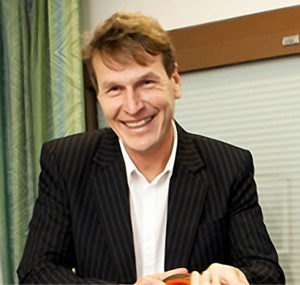 The energy trilemma – how to generate affordable, secure, and low carbon electricity – constitutes a struggle for most countries. There is an imperative to find ways of either replacing hydrocarbons or using them in a more sustainable way.
The energy trilemma – how to generate affordable, secure, and low carbon electricity – constitutes a struggle for most countries. There is an imperative to find ways of either replacing hydrocarbons or using them in a more sustainable way.
In a perfect world, renewable energy from the sun, wind waves, and the tides would meet the lion’s share of energy demand. However, in our imperfect world, much work is needed to reduce the cost of electricity generated from the new technologies.
It is a quirk of renewable energy that while the design and development of wind and solar power devices is largely the work of corporate teams, many of the emerging new wave and tidal energy devices are the brain child of one single-minded – and some might say obsessive – inventor. However, an epiphany alone does not a solution offer. The technology must be built, tested, proved, and brought to market. This is time consuming and expensive.
Wave power devices come in many shapes and sizes. Sea creatures give their name to some of them: notably the Oyster, the Pelamis (a tropical sea snake that dwells in shallow waters), and the Penguin.
That last one is a wave energy contraption invented by Finnish architect Heikki Paakkinen. He is chief innovation officer at Wello, a company that is developing and marketing the 0.5MW device, currently being tested at the European Marine Energy Centre in Orkney.
Mr Paakkinen’s fascination with wave power has been life-long affliction. At the age of fifteen, he designed a wave-powered boat made from bits of cars and bikes. He tested the prototype in a swimming pool and kept on developing the concept. The teenage inventor decided that rotation was the key: something that rotated naturally had no need to convert movement. Mr Paakkinen subsequently spent his time thinking of ways to extract rotary movement directly from waves, hence the idea of a shape which gyrates, creating the required rotation inside the machine.
Since wave power did not offer any real career prospects, the young designer continued to cultivate and perfect his ideas while gainfully employed as an architect. However, wave power kept its hold on him. Grappling with the problem of friction, Mr Paakkinen eventually came up with the enclosed shape that is now the hallmark of the Penguin.
The Penguin is an asymmetric rotating mass designed so that its moving parts are enclosed within and protected from the elements. It operates by capturing rotational energy generated by the movement of its oddly shaped hull which rolls, heaves, and pitches with each passing wave. Inside the hull, the motion powers a spinning flywheel, which drives an electric generator to produce electricity that is transmitted ashore via a subsea cable.
The first prototype Penguin was made out a single metre of hollow Styrofoam with a piece of wood turning on the top. The designer tested it in a small protected cove while rocking a boat to simulate wave action. Mr Paakkinen remembers this as the first time when he could shed all doubts regarding the feasibility of his invention and realised he was on to something of momentous importance. He also had a strong feeling that more work should be undertaken to fully develop the Penguin.
Working with his brother, and with the support of a friendly banker, bigger models soon followed. The trio assembled a larger three-metre model on a 1:100 scale which they tested both at sea and in a wave tank with good results. Progress was rapid: in 2009 they built an early scale 1:8 prototype, and a year later had the first full-size model ready for deployment.
The first Penguin was put together at a shipyard in Riga, Latvia, and towed to Orkney where it has undergone extensive testing to prove the concept, its robustness in rough seas, and other important parameters that determine the device’s viability.
In May 2015, the EU Horizon 2020 Programme awarded EUR17 million to install a test array of several Penguins at the Wave Hub test centre off the coast of Cornwall. This meant that Mr Paakkinen’s boyhood dream of wave-powered electricity is moving a step closer to reality.
Marine energy – using wave and tidal power to generate electricity – is still in its infancy and lags perhaps a decade or so behind offshore wind power. With its long coastline and exposure to strong waves and big tides, the UK boasts some of the best wave and tidal sites in Europe. Marine energy has the potential to supply up to a fifth of Britain’s electricity demand, but the competing technologies are still in the pre-commercialisation stages. Many challenges lie ahead before wave and tidal power is ready to supply electricity to homes and businesses.






























